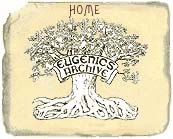
Eugenics Popularization
Steve Selden, University of Maryland
Eugenic ideology was deeply embedded in American popular culture during the 1920s and 1930s. For example, on Saturday night, high school students might go to the cinema to see "The Black Stork" – a film that supported eugenic sterilization. In church on Sunday, they might listen to a sermon selected for an award by the American Eugenics Society – learning that human improvement required marriages of society's "best" with the "best."
On a field trip to a state fair with their hygiene class, students might sign up for a eugenic evaluation at a Fitter Families Exhibit – hoping to win a medal claiming, "Yea I Have A Goodly Heritage." Back in school, these same students might open their biology textbooks to the chapter on eugenics – which recommended the eugenic policies of immigration restriction, sterilization, and race segregation.
Eugenics traces its roots to Britain in the early 1880s, when Sir Francis Galton coined the term to mean "well-born". Galton thought that biological inheritance of leadership qualities had determined the social status of Britain's ruling classes. In his view, nature was far more important than nurture in human development. Early in the 20th century, eugenics had landed on American shores. The American Breeders Association (ABA) devoted itself to investigating issues that would have interested Sir Francis Galton. With a committee focusing on the presumed hereditary differences between human races, the ABA popularized the themes of selective breeding of superior stock, the biological threat of "inferior types," and the need for recording and controlling human heredity.
Financial support for the popularization of eugenics came both from individuals and foundations in America. In 1906, John Harvey Kellogg created the Race Betterment Foundation in Battle Creek Michigan, which sponsored a series of conferences at its sanitarium in 1914, 1915, and 1928. Beginning in 1910, the Eugenics Record Office propagandized eugenics with financial support from Mrs. E. H. Harriman and the leadership of Charles Davenport and Harry Laughlin.
By 1918, a group of socially prominent and influential men organized the Galton Society. Reflecting its namesake's interests, the Society was concerned with presumed human racial differences and policies of differential breeding. Under the direction of eugenicists such as Davenport and racist authors, Madison Grant and Lothrop Stoddard, the Galton Society brought together scientific and philanthropic leaders to popularize eugenics through a newsletter, the Eugenical News. Eugenics was also popularized through a series of International Congresses of Eugenics held in 1912, 1921, and 1932. After the second of these meetings, the American Eugenics Society (AES) was formed. The AES organized several committees devoted to popularizing eugenics: Cooperation with Clergymen, Religious Sermon Contests, Crime Prevention, Formal Education, and Selective Immigration.
The AES also organized Fitter Families Contests and eugenics exhibits at state fairs at locations as varied as Topeka, Kansas and Springfield, Massachusetts throughout 1920s. Typical of the tone of these exhibits, the 1926 display in Philadelphia warned that "some Americans are born to be a burden on the rest." The display used flashing lights to emphasize the supposed dire consequences for America's prosperity if the reproduction of inferior persons was not controlled.
Eugenics also had the support of leaders in academia. E.L. Thorndike and Leta Hollingworth popularized eugenics to generations of prospective classroom teachers. Using flawed racial interpretations of the intelligence test data after the First World War, psychometricians such as Carl Brigham and Robert Yerkes added to eugenics' unjustified luster in the public eye.
At the same time, the popular authors Henry H. Goddard and Edward A. Wiggam recommended policies of controlled breeding for American citizens. Traveling across the country with lantern-slide presentations, they warned of a "rising tide of feeblemindedness" and demanded a "new decalogue of science" – a modern ten commandments based upon eugenic principles.
After 1914, courses on eugenics were being offered at some of America's leading universities. Harvard, Columbia, Cornell, and Brown were among those listing courses that included eugenics. In the 1920s, the National Education Association's Committee on Racial Well-Being sponsored programs to help college teachers integrate eugenic content in their courses.
By 1928, eugenics was a topic in 376 separate college courses, which enrolled approximately 20,000 students. A content analysis of high school science texts published between 1914 and 1948 indicates that a majority presented eugenics was as legitimate science. These texts embraced Galton's concept of differential birthrates between the biological "fit" and "unfit," training high school students that immigration restriction, segregation, and sterilization were worthy policies to maintain in American culture.
While eugenics was indeed popular, it was poor science and it was rejected on scientific grounds. However, the hereditarian social attitudes that supported popular eugenics remain in the public consciousness to this day. From news stories about "novelty-seeking" genes, to supposedly academic tomes on intellectual "bell curves," to "reawakened" racist interpretations of American history, the social seeds for resurgent eugenics are still alive. If we are not to repeat the errors of the past, we will need to examine modern eugenic visions with intellectual rigor.
